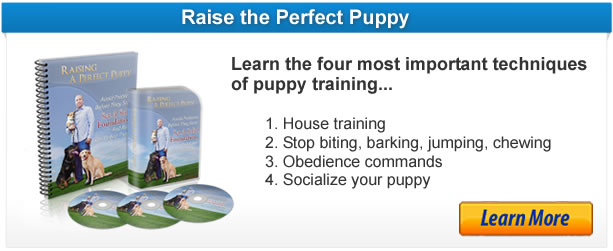There are four steps to my house training formula and I’m going to go through each step in detail:
1- Prevention- Dogs are creatures of habit. This is one of their qualities that allow them to be trained. If a dog gets locked into one behavior pattern that is the behavior pattern that is the most likely to persist. Only some sort of catalyst can change a behavior pattern. In the case of training a dog, YOU are the catalyst. If preventing your dog from going to the bathroom in the house is going to occur it is going to be due to YOUR actions. Prevention boils down to two main methods:
a. Crate training. Regardless of whether your canine is a puppy or adult he needs crate training if he isn’t house trained. Keep your puppy in his crate when you aren’t home, while you sleep, and any other time you can’t pay attention to him. In the beginning this may be a lot but don’t worry, you will be able to wean him off the crate eventually. Here are a few tips for acclimating your puppy to the crate:
i. Don’t put stuff in there. Things like beds and flimsy toys are liable to get destroyed and many dogs have choked on bedding while being in their crate. Bedding is also soft and absorbent. Guess what puppies like to pee on? Soft and absorbent stuff like grass, dirt, YOUR CARPET, and bedding left in the crate. ii. Feed your
puppy in the crate. Don’t LEAVE food in the crate but when it comes time for a meal put him in there with the food for 15 minutes then take it out.
iii. Put your puppy in for a few seconds and a few moments here or there only to let him right out. If your puppy goes in the crate 10 times a day but really only stays in there for any significant time once or twice you will ‘trick’ your dog into realizing that the crate isn’t some sort of end all that he needs to fear.
b. Keep your puppy on a leash in the home. This may sound strange to have a dog on the leash in the house but it does so many great things:
i. It allows you to SEE everything. As a puppy owner you need to control how your puppy interacts with every part of his environment. You need to control how he interacts with your couch; does he jump on it or leave it alone? You need to control how he responds to your guests; does he pester them or does he leave them alone? You need to control how he interacts with your carpet; does he pee on it or does he walk on it? If you want to control his interaction with his environment you need to SEE his interaction with his environment. You can’t find an ‘accident’ after the fact and do anything about it. You need to see things as they happen and the leash allows you to do that. Leash training isn’t only critical for the house training part of this section but also will be vital for training manners.
ii. It sets the tone for your home. I enter a lot of homes where the client’s dog is now an adult and is constantly doing laps and is basically a frantic fool. By keeping the dog on a leash from a young age you prevent the dog from growing up being wild and crazy in the home. If he never had the chance to do so he is much more likely to be calm as he matures. This also goes for adult dogs. You can effectively reverse a chaotic and hyper dog with some leash training around the house.
iii. Leash training forms a close bond. The leash is a literal tie to you and really helps the dog look to you as a leader. Remember, leash training in the house isn’t forever. It is a good way to start proper training and proper relationship, though.
2- Encourage the puppy to use the bathroom outside- This is perhaps the easiest part of house training a dog and I find that many people are already doing it. Very simple, when your puppy goes to the bathroom outside praise him. Throw him a party! Pet him and give him treats and tell him that he is doing the right thing.
3- Correct the dog when he uses the bathroom inside- There is a method that is becoming more prevalent in recent years. This method calls for ignoring your puppy when he goes to the bathroom in the house and simply taking him outside. This is crazy! The puppy learns that going to the bathroom outside is good but never learns that going to the bathroom inside is wrong.
Correcting a puppy for using the bathroom in the house is important but don’t confuse corrections with harshness. You don’t need to be mean to correct a dog. With your dog on a leash, however, you are in the perfect position to quickly correct your dog for accidents. As your puppy begins to squat to relieve himself start rushing for the door as you give a few swift and firm tugs on the leash. Say ‘no’ a few times as you do so. Make sure your corrections are propelling you toward the door so that you can quickly get him outside. Hopefully he can finish his bathroom break outside so that you can praise him for that.
If you can consistently praise him for using the bathroom outside and consistently correct him for using the bathroom inside it is a no-brainer what is going to occur with time.
4- Get your dog on a routine/schedule- There are three things that I like to put on a routine with my puppies or adult dogs that are being house trained.
a. Food- It is important that your dog not have access to food all day long. He should be fed on a schedule. Put down his food dish, or better yet, put it in his crate. Allow him 15 minutes and if he eats, great. If he doesn’t, he’ll be hungrier next time. Scheduled feedings are good for your dog’s health. Young puppies need meals and big injections of calories. If you leave food out all day your puppy is likely to get very picky and only eat a bit here or there.
Scheduled feedings are also good for establishing dominance. If food is left out for him all day that means that food has nothing to do with you. He needs to know that YOU are the giver of food. Food equals paycheck to a dog. If the dog has a never ending bowl of paycheck, what does he need you for?
Scheduled feedings are also good for house training. If you know when your dog is eating you also start to know when he needs to poop.
b. Water- I try to make sure that my puppies don’t take enormous drinks. Enormous drinks make it hard to hold it. If I see my pup drinking for longer than normal I’ll just use the leash to get him away from the water dish until a bit later.
With young puppies I also control their evening water intake. If the puppy is having a hard time making it through the night without waking up I will take away the water about three hours before bedtime.
c. Bathroom breaks- Take your pup out to the bathroom first thing in the morning (and I mean first thing, even before taking care of yourself) and last thing at night (and I mean last thing, even if you have to wake your puppy up to go potty). Take your puppy out right after eating AND one hour after eating. Take your puppy out about 15 minutes after a big drink, take him out after a big play session, and take him out any time you return home and take him out of the crate.
This house training system works great. In a nutshell we prevent the dog from going to the bathroom in the house, correct him when he does, encourage him to go potty outside, and set up a routine for his success. We cover the house training from every angle.
This is only the first part of house training, though. We need to eventually wean him off the leash and the crate so that you can give your dog free run of the home. Here is how you do it:
- When you notice that your dog is doing great and has been several weeks without an accident then start giving him more freedom. Keep the leash on him but let it drag around instead of you holding it. Allow him to venture around the room you are in but don’t allow him to get out of sight yet.
- As he does well with this step then you can let him briefly leave your sight and venture into the next room for a few moments before you call him back.
- When he is doing well at this stage of freedom then start to allow him to roam the house WHILE you are home. He is still in the crate while you are gone.
- When he has free run of the house while you are home then you can allow him to sleep outside the crate at night time. At this point I switch to a ‘tab leash’ as well. This is a simple leash that you can make with 12″-18″ of light rope and a leash clip. It allows you to maintain some level of control but doesn’t give complete freedom yet.
- When he is doing great at this stage then start leaving him out of the crate while you leave the house. Start out by leaving for only two minutes, then five, then ten and so on. VERY GRADUALLY you will increase the length of time that you are gone until he can be alone for hours at a time while you are gone. At this point I have the dog leash-less basically all the time. You should have no more need for a regular leash or a tab leash around the house.
- At any point, as you are increasing the freedom you are giving him, if he backslides and goes potty in the house just take it in stride. Go back a step in the freedom he was allowed and build him back up to where he can do better.
These aspects of prevention, encouraging good behavior, correcting inappropriate behavior, and building a routine aren’t only for house training. They also serve for house manners. Think about it, chewing falls under this same umbrella. If we can prevent chewing from happening through supervision, encourage him to chew on his toys, and correct him for chewing on your stuff we can fix a chewing problem. Insert that same logic into a problem of getting on the couch, stealing your socks, or whatever other ‘manners’ problem your dog has.




Follow Us!
By FRESCIGSUK e cigarette